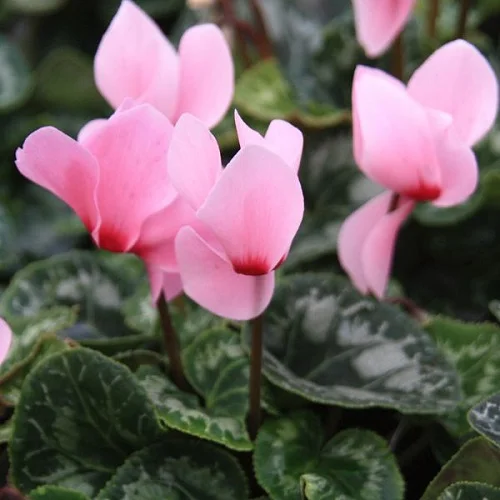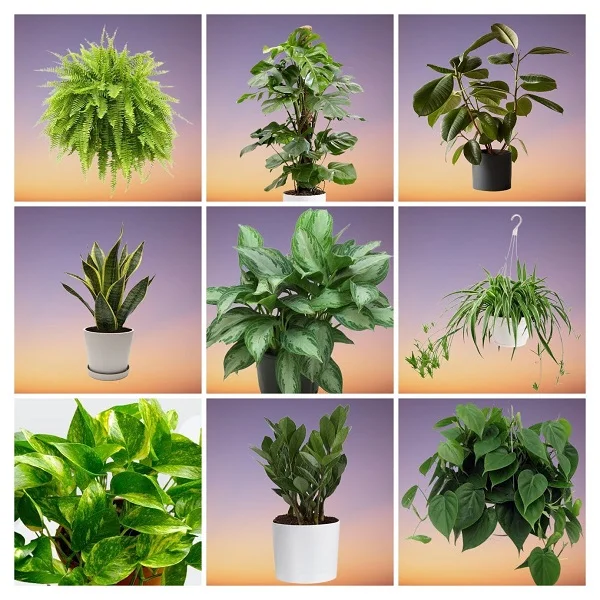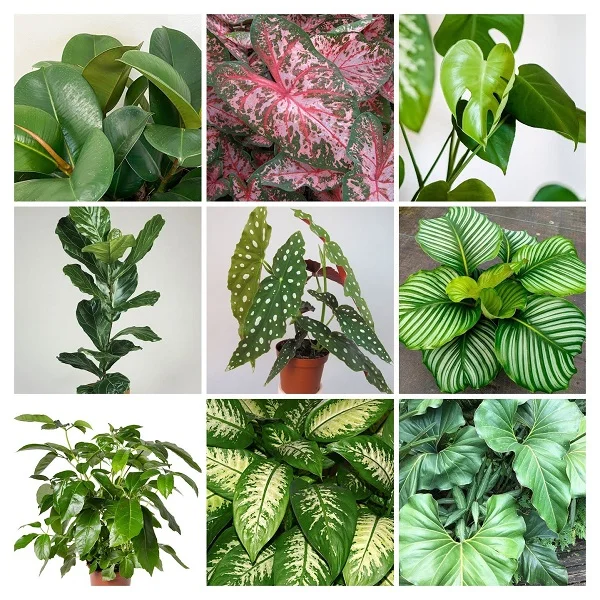Cyclamen persicum Care Indoors, Propagation, Common Problems and Solutions
Some links in this post may be affiliate links
Cyclamen persicum flourishes in bright indirect light, warm and humid conditions, and consistently moist, rich, well-drained soil coupled with fortnightly feeding in the growing season.
Cyclamen persicum or simply Cyclamen is among the popular flowering plants and bears beautiful flowers and decorative foliage but will not last very long under room conditions.
However, with proper care, Cyclamen will bloom indoors for several months. It is a low-growing, compact plant and is included in the best plants for the limited spaces like a window sill, hanging basket, tabletop, desktop or plant shelf.
The leaves are heart-shaped, fleshy and smooth-textured. The upper leaf surface has a green-silvery marbled color and the underside may be pale-green or reddish.

Botanical name: Cyclamen persicum
Family: Primulaceae
Origin
Cyclamen persicum is native to North Africa across West Asia to Southeast Europe.
Size
Cyclamens are herbaceous perennial plants which grow from a tuber to a height of about 1 ft. It is one of the best plants for limited spaces and it is among the best plants for an office desk with no windows.
Flower
Cyclamen Plants blooms from winter to spring. The flower are usually white to pink with a band of deep-pink at the base. The flower stalk is a long upright stem that rises above the leaves.
Is Cyclamen persicum toxic?
Yes. All parts of Cyclamen persicum are toxic to both humans and pets. They contain saponins which if ingested can cause drooling, vomiting and diarrhea.
How to Care for Cyclamen persicum Indoors
To care for Cyclamen persicum indoors, provide bright indirect light, warmth of 10-180C, humidity of 70-80% and consistently moist, rich, well-drained soil coupled with fortnightly feeding during the growing season.
Cyclamen requires regular pruning to keep it tidy as well as encourage flowering. Repotting is only necessary when pot-bound as it blooms best when root-bound. A rest period is also needed to encourage flowering. Keep reading for more on these growing conditions and how to achieve them.

Light Requirements
Do Cyclamen like sun or shade
Cyclamen grows best in bright indirect light (filtered light). Keep it away from direct sunlight to avoid scorching.
If the light is too low, it will not bloom and will become leggy with pale leaves. Therefore, where the natural light is not adequate, you may use full spectrum grow lights to supplement it.
Turn the pot regularly to ensure the plant receives light on all sides for even growth and prevent lopsided growth.
Watering
How often should I water Cyclamen?
Water Cyclamen liberally in the growing season while allowing the top 1-2 inches of soil to dry out between waterings. Keep the soil consistently moist but not soggy to prevent rotting, yellowing and leaf fall.
Cut down on watering in the dormant season to keep the soil slightly moist. Do not allow the soil to dry out completely to prevent wilting, yellowing and leaf drop.
Avoid wetting the foliage; water from the bottom or use the immersion method as wetting the foliage can lead to fungal diseases and death of the plant.
Temperature & Humidity
Cyclamen persicum thrives in cool temperatures of 10-180C. Keep it from drafts to avoid sudden changes in temperature which can result in stunted growth and leaf drop.
Cyclamen prefers a humidity of 70-80%. Group the plants together, set the pot on a wet pebble tray or use a cool mist humidifier to elevate humidity. Do not wash or mist the leaves as it can lead to crown and stem-rot disease. Maintain good air circulation to prevent fungal infestations.
Fertilizer
Feed Cyclamen persicum with a phosphorous-rich, water-soluble fertilizer every 2-3 weeks during the bud formation stage to promote flowering.
Potting Medium
The best soil for Cyclamen Plant should be rich in organic matter and free-draining to prevent it from getting soggy while providing the required nutrients. A blend of 2 parts organic potting mix and 1 part perlite (for drainage) is ideal for this plant.
Repotting
Keep Cyclamen persicum pot-bound to promote flowering as it blooms best when pot-bound. Repot during the dormant period only when the soil becomes compacted. Repotting every 2 years should be adequate for this plant.
Use a pot 1 size larger than the current one and ensure that it has a drainage hole and the soil is well-draining to prevent waterlogging. Take a look at these pots with drainage holes on Amazon.
After repotting place the plant in a shaded place and keep it dry. Resume watering after 6-8 weeks to encourage new growth.
Pruning & Grooming
Pruning Cyclamen persicum is easy. Remove spent blooms and any side shoots to encourage development of more flowers. Get rid of dead leaves to keep the plant neat and reduce pest and disease infestations.
Regularly clean the leaves by damp-wiping with a soft cloth to get rid of dust as well as discourage pest and disease infestations.
How to Care for Cyclamen persicum after flowering
After flowering is over and the foliage turns yellow, cut back the stems.
Place the plant in a cool dark place and maintain the soil barely moist for about 6-8 weeks. Withhold feeding during this period.
As soon as new growth emerges, move the plant to a bright spot and water thoroughly.
Keep it cool at temperatures between 16-180C and cooler night temperatures.
Begin monthly feeding with a balanced, water-soluble fertilizer. The plant should start blooming in about 2-3 months.
Cyclamen persicum Propagation
Cyclamen persicum is propagated by plant division or from seeds. It is best propgated at the beginning of the growing season when in active growth for faster establishment.
1. Propagating Cyclamen persicum by plant division
When flowering is over and the foliage has started to yellow, cut back the foliage, dig up the tubers and clean off the soil.
With a sharp sterilized knife, divide the tuber into sections and ensure each section has a growing point (nub or eye) from which the foliage will grow.
Place the sections in moist, free-draining soil with the nub sticking above the soil surface.
Maintain the soil moist but do not wet the nubs as it can lead to rotting.
Allow enough time for the nubs to develop into new plants after which you can begin routine care.
2. Propagating Cyclamen persicum from seeds
Cyclamen persicum seeds do not last very long therefore ensure the seeds are very fresh.
Spread the seeds on moist soil and cover the seeds lightly with soil and place the set up in a dark place.
Maintain the temperatue at about 180C. The seeds should germinate in 20-30 days.
After germination place the seedlings in a well-lit place and start routine care.

Cyclamen persicum Problems & Remedies
Cyclamen persicum common problems are yellowing leaves, short flowering period, plant dying, pests and diseases among others. Keep reading for more on these problems and how to fix them.
Yellowing leaves
Why do Cyclamen leaves turn yellow?
Some of the causes of yellow leaves on your Cyclamen are too little light, soggy soil, inconsistent watering, temperature stress, nutrients deficiency, dry air, direct sunlight or aging.
How to fix it
Too little light: Position the plant in bright indirect light or use a grow light if you do not have enough light in your home.
Soggy soil: Use fast-draining soil and a pot with a drainage hole.
Inconsistent watering: Water when the top 1-2 inches of soil feel dry to the touch but do not allow the soil to dry out completely.
Temperature stress: Keep the plant away from sources of drafts like hot air vents, AC units, hot surfaces, windy doors, drafty windows among others.
Nutrients deficiency: Feed the plant monthly during the growing season with a balanced, water-soluble fertilizer.
Dry air: Set the pot on a wet pebble tray, use a cool mist humidifier or group the plants together to increase humidity.
Direct sunlight: Move the plant to a shaded place or shield it from direct sunshine with a light curtain.
Aging: This is a natural process. As the lower leaves mature, they turn yellow, brown and eventually die.
Short flowering period
Cyclamen short flowering period is caused by too much warmth, inconsistent watering, insufficient light, dry air or nutrients deficiency.
How to fix it
Too much warmth: Move the plant to a cooler place to maintain temperatures of 10-180C.
Inconsistent watering: Water when the top 1-2 inches of soil feel dry to the touch. Do not water on a schedule.
Insufficient light: Place the plant in bright indirect light or use a grow light if you do not have adequate light in your home.
Dry air: To raise the humidity, set the pot on a wet pebble tray, use a cool mist humidifier or group the plants together.
Nutrients deficiency: Feed it every 2-3 weeks with a phosphorous-rich, water-soluble fertilizer in the bud formation stage.
Plant dying
Cyclamen persicum is dying due to crown and stem-rot which is promoted by wetting of the crown during watering. It presents with a soft, rotten crown.
How to fix it
- Discard the affected plant as it will not recover.
- Avoid wetting the crown in future; water from the bottom in the future.
- Use a pot that has a drainage hole and well-draining soil to prevent waterlogging.
Pests
Common pests on Cyclamen are aphids and cyclamen mites which attack the growing points, thereby causing twisted and stunted leaves.
How to fix it
- Isolate the affected plant to prevent spread to the rest of the plants.
- Treat the plant with a horticultural oil as per the manufacturer's instructions.
- Regularly check underneath and between the leaves for these pests and carry out timely control measures.
- Keep the plant well pruned and raise humidity to discourage the pest infestations.
Diseases
Cyclamen persicum is prone to botrytis disease which presents as yellowing leaves with brown patches and is brought about by soggy soil coupled with poor air circulation.
How to fix it
- Isolate the affected plant to prevent spread to other plants.
- Treat the plant with a systemic fungicide as per the manufacturer's recommendations.
- Maintain good air circulation to discourage the disease.
- Use a pot that has a drainage hole and well-draining soil to prevent the soil from getting soggy.
You liked it? Share on social media.
Related Content
Amazon Associates Disclosure
Homeplantsguide.com is a participant in the Amazon Services LLC Associates Program, an affiliate advertising program designed to provide a means for sites to earn advertising fees by advertising and linking to amazon.com.





